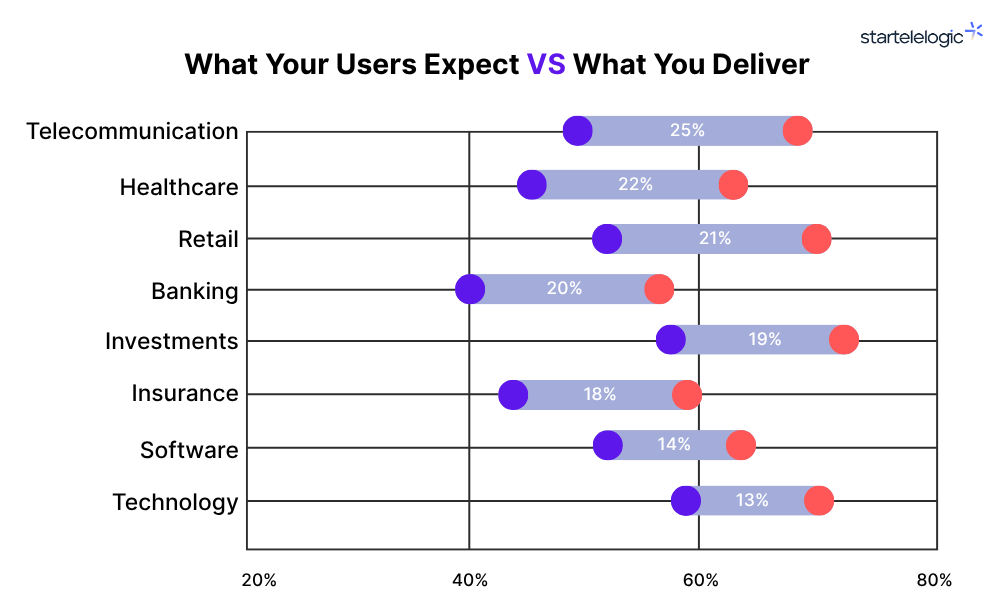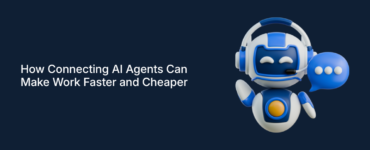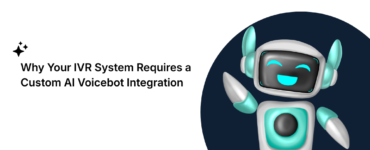A seismic shift is occurring across customer service landscapes, driven by increasing user expectations and rapidly evolving digital touchpoints. While businesses invest heavily in front-end digital transformation, their support systems often remain reactive, disjointed, and heavily reliant on human operators. According to Gartner, over 60% of customers now expect support interactions to feel personalized and predictive — yet most industries are still failing to close that delivery gap. This growing disconnect has accelerated the adoption of AI in call centres for cognitive customer engagement, enabling enterprises to deliver smarter, faster, and more contextual service at scale.
The graphic below illustrates this expectation-delivery divide across industries. Healthcare shows a 25% gap, followed by pharma (22%), retail (21%), and banking (20%). These gaps directly correlate with support system maturity and the level of AI integration in customer service processes.
This mismatch highlights the critical need for AI in call centres for cognitive customer engagement — where AI doesn’t just automate but understands, adapts, and learns.

The Limitations of Traditional Contact Centres
Legacy contact centres were built for volume, not personalization. They rely on static scripts, fragmented systems, and overworked agents. This model cannot scale in today’s omnichannel, expectation-driven environment.
Some of the most common issues plaguing conventional support systems include:
- Inability to personalize interactions at scale
- Lack of unified customer view across channels
- High first-response time and agent burnout
- Poor knowledge retrieval systems
- Low-quality post-call insights and analytics
What’s needed is a system capable of cognition — an engine that listens, interprets, and evolves with each customer interaction.
AI Transformation in Contact Centres: A Strategic Imperative
AI transformation in contact centres introduces dynamic systems that can comprehend context, offer real-time suggestions, automate low-value tasks, and learn continuously from data.
Rather than replacing agents, AI acts as a cognitive collaborator. Here’s how transformation plays out:
- Conversational AI manages repetitive queries and frees human agents for more complex tasks.
- Predictive analytics identifies churn signals and service gaps before they affect loyalty.
- Sentiment detection adapts tone and responses based on customer mood in real time.
- Machine learning models update workflows, improve response accuracy, and reduce handle times.
AI allows contact centres to shift from cost centers to customer intelligence hubs.
Three Foundational Pillars of AI in Call Centres
Effective AI implementation is never a patchwork of tools — it’s a structured framework that spans the entire support journey. The visual below outlines three interconnected pillars:

1. Pre-call Contextual Understanding
AI scans previous tickets, CRM data, call logs, and web behavior to assess what the customer likely needs before they say a word. Key functions include:
- Intent detection from historical patterns
- Predictive call routing based on past outcomes
- Pre-population of agent dashboards with relevant data
- Auto-resolution of routine tickets (e.g., password resets)
This stage dramatically improves first-call resolution and decreases average handle time.
2. During-call Support and Agent Assistance
Live support becomes intelligent when AI systems suggest actions in real time. Key components are:
- Smart call transcription and analysis
- Real-time knowledge base surfacing
- Compliance monitoring and escalation triggers
- Sentiment tracking and next-best action recommendations
Agents gain the cognitive edge to handle more complex, nuanced issues with confidence and consistency.
3. Post-call Intelligence and Feedback Loop
Every interaction feeds into a continuous improvement engine. AI tools evaluate:
- Quality of response, tone, and resolution
- Customer satisfaction predictors
- Root cause analysis for recurring issues
- Agent performance benchmarking
Insights are looped back into training sets, knowledge bases, and workflow automations.
Contact Centre AI Process Flow: A Unified Architecture

Delivering seamless customer support today demands more than just deploying a chatbot or automating a few workflows. Modern enterprises require a unified system where AI touches every node of the customer journey — from entry point to resolution and analytics. That’s what defines a cognitive, scalable contact centre.
The AI contact centre architecture shown below represents how various systems — voice, chat, CRM, knowledge bases, and fulfillment tools — work as a cohesive, intelligent network. This integrated flow not only improves response time but also eliminates silos between departments, reduces agent workload, and ensures higher-quality resolutions.
AI-Enabled Call Centre Experience: Start to Finish
Truly transformative customer service doesn’t happen at one point of the interaction — it’s shaped across the entire lifecycle: before, during, and after the call.
This section illustrates how AI adds value at every stage, ensuring not just efficient resolution, but also a continuous feedback loop that improves both system intelligence and customer experience over time.

Pre-call: Intent Prediction and Smart Routing
AI begins working before the interaction even starts. By analyzing digital footprints — such as browsing history, previous tickets, and account data — the system predicts why the customer might be reaching out.
- Intent analysis models surface probable query types
- Predictive routing algorithms assess agent availability and expertise
- Autonomous bots resolve low-complexity queries, like balance checks or delivery updates
This results in shorter queue times, reduced agent transfers, and an intelligent first-touch experience.
During-call: Real-Time Intelligence and Agent Empowerment
When the conversation begins, AI moves into assistive mode. It provides live, context-aware support to the agent — turning each interaction into a highly personalized and efficient experience.
- Speech-to-text transcription allows real-time monitoring
- NLP engines detect sentiment, urgency, and potential escalation
- Dynamic dashboards pull up relevant past interactions and documents
Agents no longer waste time searching systems — they have the right insight at the right time, resulting in faster resolutions and better customer satisfaction.
After-call: Analytics, Insights, and Strategic Feedback
Once the call ends, AI continues to work. It reviews the interaction, captures feedback, and evaluates key performance indicators like resolution accuracy, tone, call length, and more.
- Quality scoring models benchmark each call
- Customer feedback and satisfaction signals are analyzed at scale
- Insights are used to train models, agents, and workflows
This feedback loop transforms support from reactive problem-solving to a proactive customer experience engine, constantly evolving based on data.
Why Cognitive Call Centre Solutions Are Non-Negotiable
Cognitive AI is what enables these next-gen solutions. Unlike static bots, cognitive systems learn from every call, update themselves autonomously, and deliver better accuracy with time.
Here’s what distinguishes them:
| Feature | Traditional Systems | Cognitive AI Systems |
| Data Use | Static scripts | Dynamic learning from every interaction |
| Personalization | Manual and limited | Real-time and predictive |
| Agent Support | Minimal | Real-time, contextual, and adaptive |
| Outcome Optimization | Reactive | Proactive and self-improving |
These capabilities position cognitive call centre solutions as foundational, not optional.
The Future of AI in Call Centres for Cognitive Customer Engagement
As AI capabilities mature, we will see a convergence of LLMs (large language models), multimodal data interpretation, and emotional intelligence in support interactions.
Key future shifts will include:
- Voice agents that mirror human tone and adjust emotionally
- Proactive outreach powered by customer intent signals
- Entire agent onboarding replaced by AI-assisted simulators
- Predictive issue resolution before a customer calls in
AI-powered customer engagement will evolve from response-based interaction to relationship-based support, where every touchpoint is contextually aware, emotionally intelligent, and strategically aligned.
Conclusion
AI in call centres for cognitive customer engagement is not a technology trend — it’s a transformation engine reshaping business fundamentals. Organizations leading this evolution are not just solving support challenges; they are building resilient, insight-driven customer experience models.
By embracing AI transformation in contact centres, investing in artificial intelligence in customer service, and deploying cognitive call centre solutions, enterprises are unlocking scalable efficiency, empathy, and loyalty at every interaction.
The age of passive support is over. The era of intelligent, anticipatory customer engagement has already begun.
FAQs: AI in Call Centres for Cognitive Customer Engagement
1. What is cognitive customer engagement in call centres?
Cognitive customer engagement refers to AI-driven systems that understand, learn from, and respond intelligently to customer interactions. In call centres, this means using machine learning, natural language processing (NLP), and real-time analytics to personalize responses, predict intent, and assist agents with contextual data during calls — creating smarter, faster, and more human-like customer support.
2. How does AI improve customer service in contact centres?
AI enhances customer service by automating repetitive tasks, providing agents with real-time suggestions, detecting sentiment during calls, and offering predictive routing. It enables faster response times, improved resolution accuracy, and better overall customer satisfaction. AI also collects and analyzes feedback continuously to refine service strategies.
3. What are some examples of AI-powered customer engagement tools?
Popular tools include AI chatbots, voice assistants, agent-assist platforms, real-time call transcription systems, sentiment analysis engines, and predictive analytics dashboards. These tools work together to create a unified customer service architecture capable of delivering highly personalized and efficient support at scale.
4. What industries benefit most from AI transformation in contact centres?
Industries with high customer interaction volumes — such as banking, e-commerce, insurance, telecom, and healthcare — benefit most. AI transformation enables these sectors to reduce operational costs, improve customer retention, manage complexity, and deliver omnichannel support with consistent quality.
5. How do cognitive call centre solutions differ from traditional systems?
Cognitive call centre solutions continuously learn from every customer interaction and adjust their responses over time. Unlike traditional systems that rely on static scripts and manual workflows, cognitive solutions are dynamic, predictive, and context-aware — offering a much higher level of personalization, automation, and agent empowerment.




